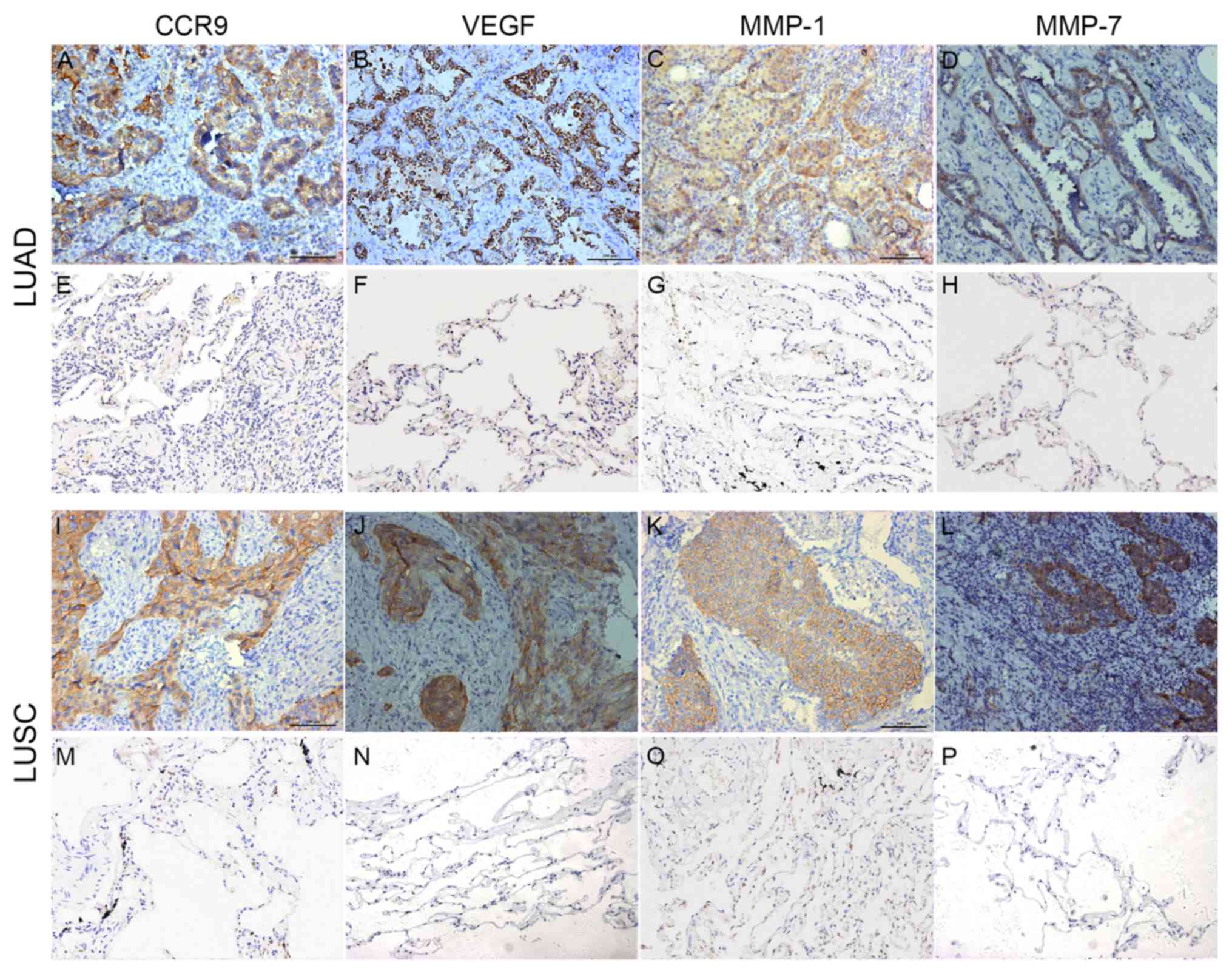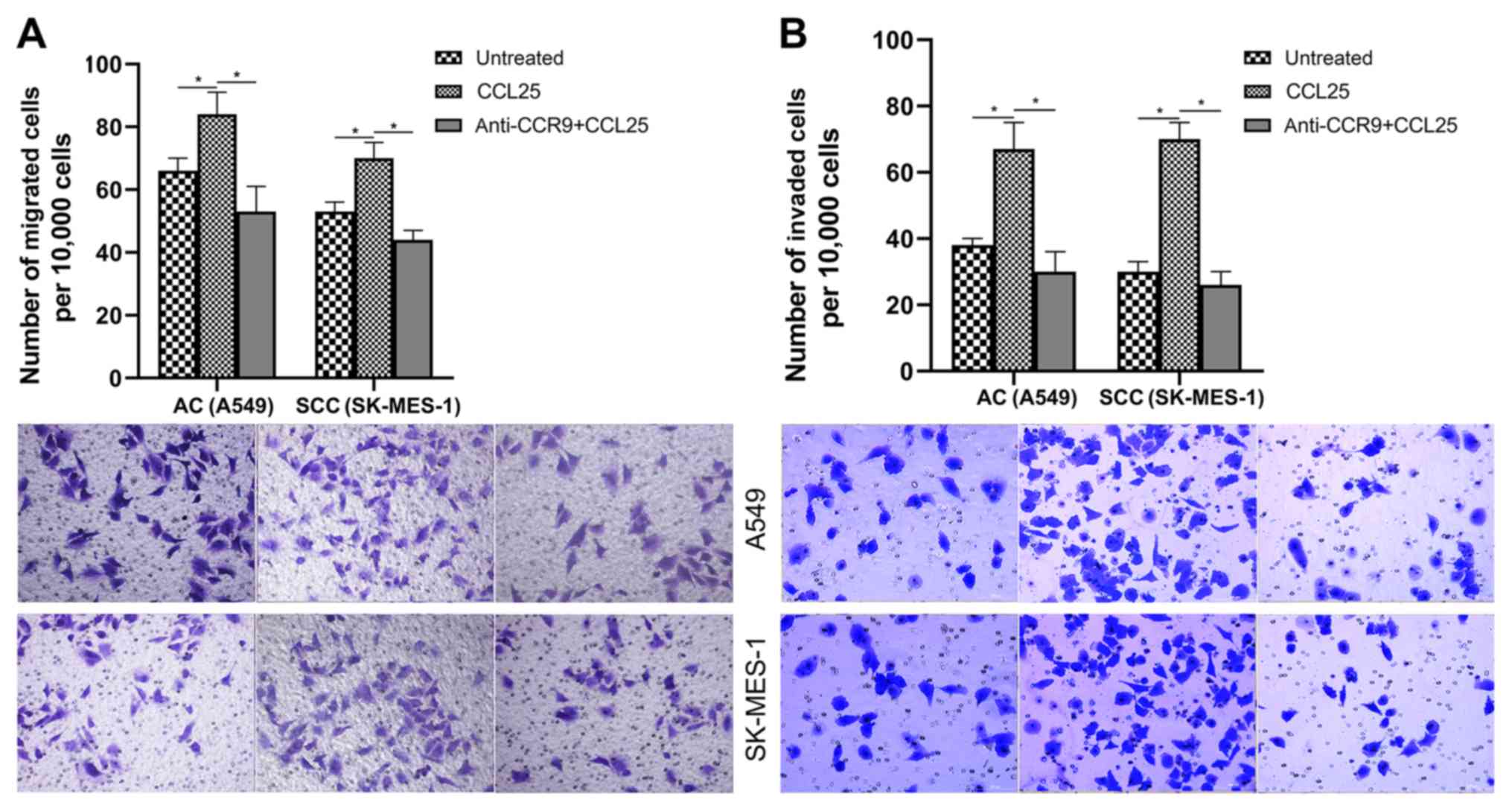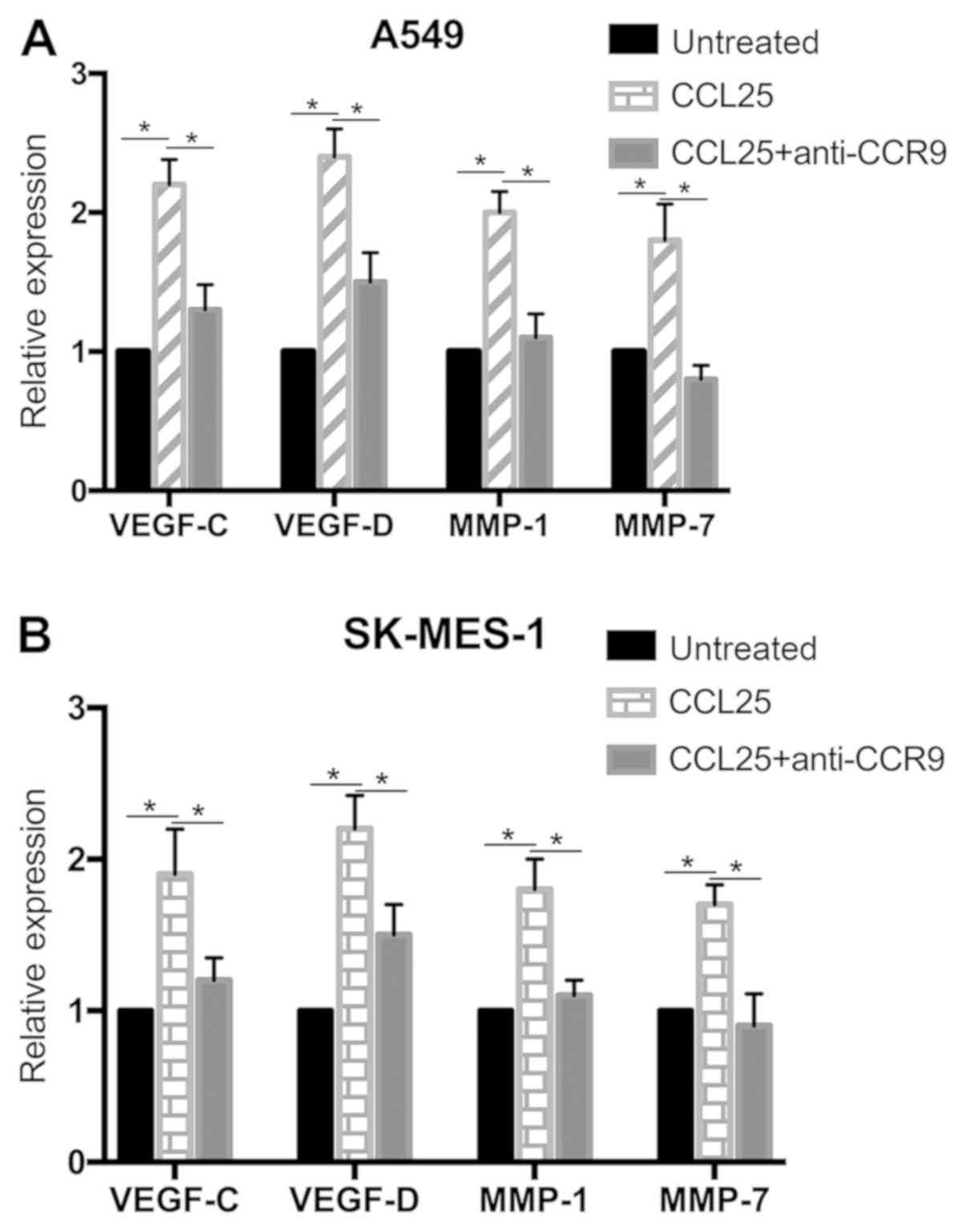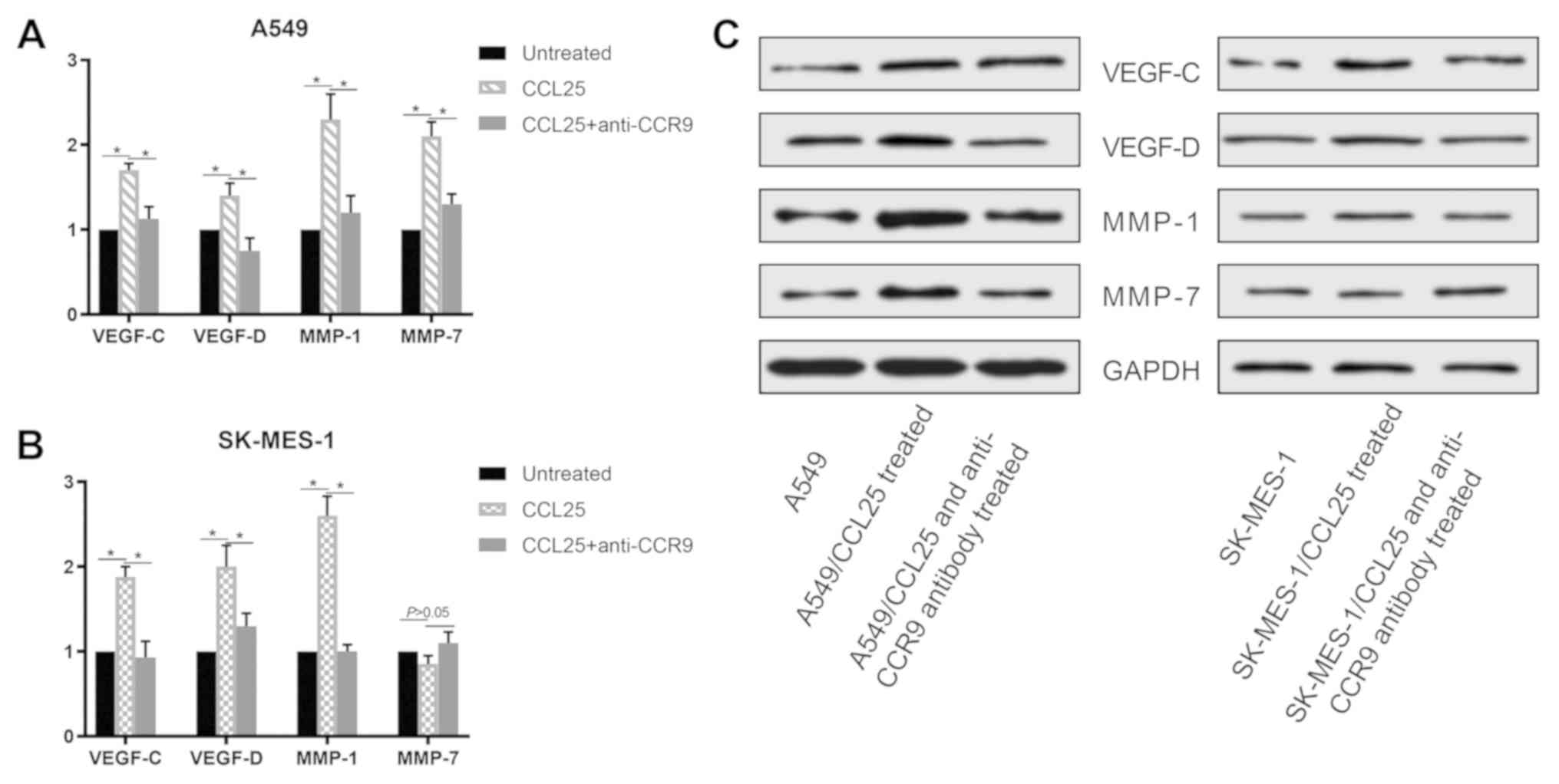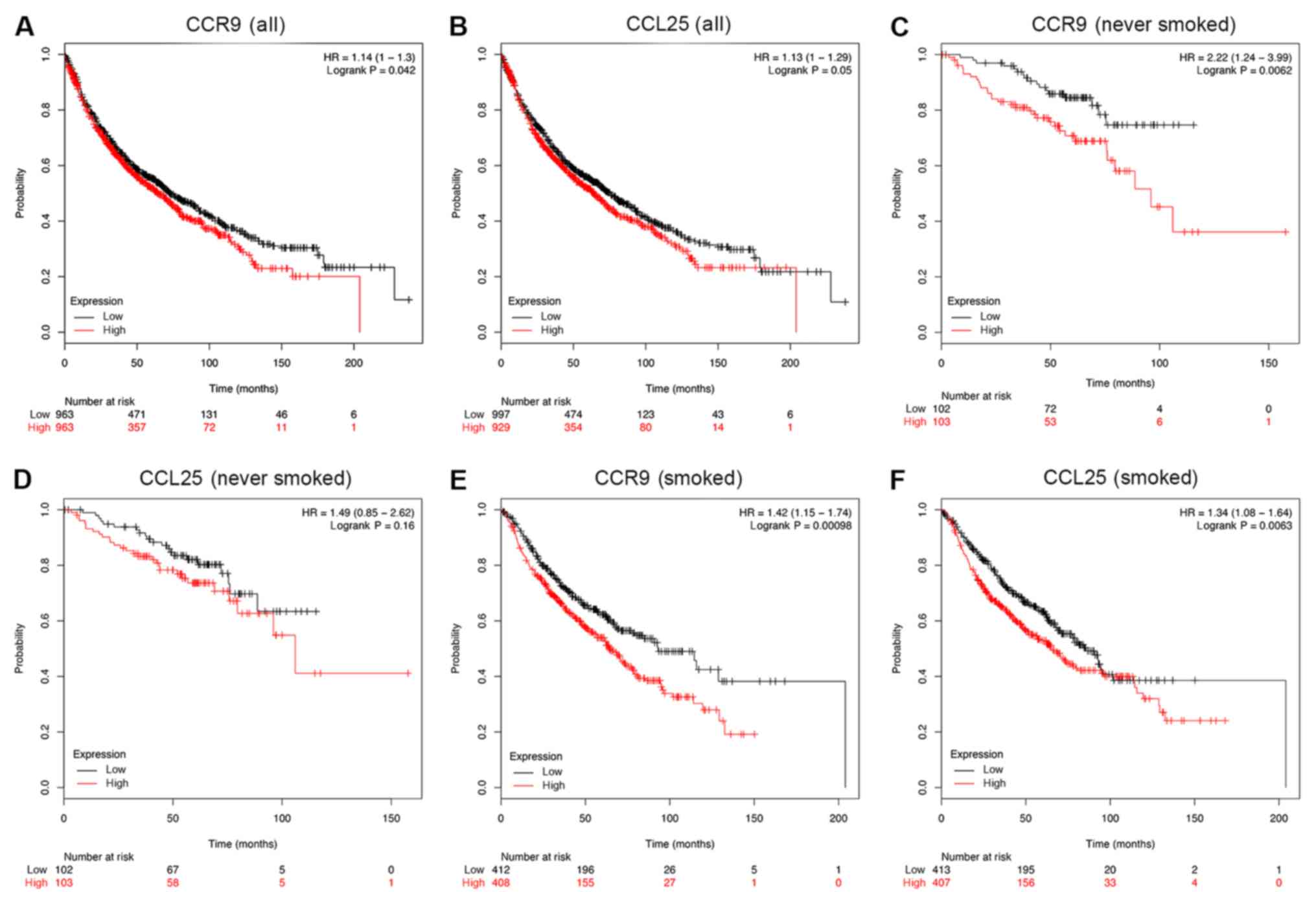|
1
|
Siegel RL, Miller KD and Jemal A: Cancer
statistics, 2019. CA Cancer J Clin. 69:7–34. 2019.PubMed/NCBI View Article : Google Scholar
|
|
2
|
Fidler IJ: Critical factors in the biology
of human cancer metastasis: Twenty-eighth GHA Clowes memorial award
lecture. Cancer Res. 50:6130–6138. 1990.PubMed/NCBI
|
|
3
|
Fidler IJ: Critical determinants of cancer
metastasis: Rationale for therapy. Cancer Chemother Pharmacol. 43
(43 Suppl):S3–S10. 1999.PubMed/NCBI View Article : Google Scholar
|
|
4
|
Strieter RM: Chemokines: Not just
leukocyte chemoattractants in the promotion of cancer. Nat Immunol.
2:285–286. 2001.PubMed/NCBI View
Article : Google Scholar
|
|
5
|
Stein JV and Nombela-Arrieta C: Chemokine
control of lymphocyte trafficking: A general overview. Immunology.
116:1–12. 2005.PubMed/NCBI View Article : Google Scholar
|
|
6
|
Olson TS and Ley K: Chemokines and
chemokine receptors in leukocyte trafficking. Am J Physiol
Regulatory Integrative Comparative Physiol. 283:R7–R28.
2002.PubMed/NCBI View Article : Google Scholar
|
|
7
|
Saintigny P, Massarelli E, Lin S, Ahn YH,
Chen Y, Goswami S and Zhang L: CXCR2 expression in tumor cells is a
poor prognostic factor and promotes invasion and metastasis in lung
adenocarcinoma. Cancer Res. 73:571–582. 2013.PubMed/NCBI View Article : Google Scholar
|
|
8
|
Su L, Zhang J, Xu H, Wang Y, Chu Y, Liu R
and Xiong S: Differential expression of CXCR4 is associated with
the metastatic potential of human non-small cell lung cancer cells.
Clin Cancer Res. 11:8273–8280. 2005.PubMed/NCBI View Article : Google Scholar
|
|
9
|
Hald SM, Kiselev Y, Al-Saad S, Richardsen
E, Johannessen C, Eilertsen M and Bremnes RM: Prognostic impact of
CXCL16 and CXCR6 in non-small cell lung cancer: Combined high
CXCL16 expression in tumor stroma and cancer cells yields improved
survival. BMC Cancer. 15(441)2015.PubMed/NCBI View Article : Google Scholar
|
|
10
|
Mukaida N, Sasaki SI and Baba T:
Chemokines in cancer development and progression and their
potential as targeting molecules for cancer treatment. Mediators
Inflamm. 2014(170381)2014.PubMed/NCBI View Article : Google Scholar
|
|
11
|
Zhu YM, Webster SJ, Flower D and Woll PJ:
Interleukin-8/CXCL8 is a growth factor for human lung cancer cells.
Br J Cancer. 91(1970)2004.PubMed/NCBI View Article : Google Scholar
|
|
12
|
Phillips RJ, Burdick MD, Lutz M, Belperio
JA, Keane MP and Strieter RM: The stromal derived
factor-1/CXCL12–CXC chemokine receptor 4 biological axis in
non-small cell lung cancer metastases. Am J Respir Crit Care Med.
167:1676–1686. 2003.PubMed/NCBI View Article : Google Scholar
|
|
13
|
Gupta P, Sharma PK, Mir H, Singh R, Singh
N, Kloecker GH and Singh S: CCR9/CCL25 expression in non-small cell
lung cancer correlates with aggressive disease and mediates key
steps of metastasis. Oncotarget. 5(10170)2014.PubMed/NCBI View Article : Google Scholar
|
|
14
|
Li B, Wang Z, Zhong Y, Lan J, Li X and Lin
H: CCR9-CCL25 interaction suppresses apoptosis of lung cancer cells
by activating the PI3K/Akt pathway. Med Oncol.
32(66)2015.PubMed/NCBI View Article : Google Scholar
|
|
15
|
Zhong Y, Jiang L, Lin H, Li B, Lan J,
Liang S, Shen B, Lei Z and Zheng W: Expression of CC chemokine
receptor 9 predicts poor prognosis in patients with lung
adenocarcinoma. Diagn Pathol. 10(101)2015.PubMed/NCBI View Article : Google Scholar
|
|
16
|
Livak KJ and Schmittgen TD: Analysis of
relative gene expression data using real-time quantitative PCR and
the 2(-Delta Delta C(T)) method. Methods. 25:402–408.
2001.PubMed/NCBI View Article : Google Scholar
|
|
17
|
Győrffy B, Surowiak P, Budczies J and
Lánczky A: Online survival analysis software to assess the
prognostic value of biomarkers using transcriptomic data in
non-small-cell lung cancer. PLoS One. 8(e82241)2013.PubMed/NCBI View Article : Google Scholar
|
|
18
|
Campbell JD, Alexandrov A, Kim J, Wala J,
Berger AH, Pedamallu CS and Imielinski M: Distinct patterns of
somatic genome alterations in lung adenocarcinomas and squamous
cell carcinomas. Nat Genet. 48(607)2016.PubMed/NCBI View
Article : Google Scholar
|
|
19
|
Imielinski M, Berger AH, Hammerman PS,
Hernandez B, Pugh TJ, Hodis E and Sougnez C: Mapping the hallmarks
of lung adenocarcinoma with massively parallel sequencing. Cell.
150:1107–1120. 2012.PubMed/NCBI View Article : Google Scholar
|
|
20
|
Ellrott K, Bailey MH, Saksena G, Covington
KR, Kandoth C, Stewart C and Sofia HJ: Scalable open science
approach for mutation calling of tumor exomes using multiple
genomic pipelines. Cell Systems. 6:271–281. 2018.PubMed/NCBI View Article : Google Scholar
|
|
21
|
Cancer Genome Atlas Research Network:
Comprehensive genomic characterization of squamous cell lung
cancers. Nature 489: 519, 2012.
|
|
22
|
Skov BG, Høgdall E, Clementsen P, Krasnik
M, Larsen KR, Sørensen JB and Mellemgaard A: The prevalence of EGFR
mutations in non-small cell lung cancer in an unselected Caucasian
population. APMIS. 123:108–115. 2015.PubMed/NCBI View Article : Google Scholar
|
|
23
|
Shi Y, Li J, Zhang S, Wang M, Yang S, Li N
and Zheng M: Molecular epidemiology of EGFR mutations in Asian
patients with advanced non-small-cell lung cancer of adenocarcinoma
histology-Mainland China subset analysis of the PIONEER study. PLoS
One. 10(e0143515)2015.PubMed/NCBI View Article : Google Scholar
|
|
24
|
Hirsch FR and Bunn PA Jr: EGFR testing in
lung cancer is ready for prime time. Lancet Oncol. 5:432–433.
2009.PubMed/NCBI View Article : Google Scholar
|
|
25
|
Haratake N, Seto T, Takamori S, Toyozawa
R, Nosaki K, Miura N, Ohba T, Toyokawa G, Taguchi K, Yamaguchi M,
et al: Short progression-free survival of ALK inhibitors sensitive
to secondary mutations in ALK-positive NSCLC patients. Thorac
Cancer. 10:1779–1787. 2019.PubMed/NCBI View Article : Google Scholar
|
|
26
|
Zlotnik A and Yoshie O: Chemokines: A new
classification system and their role in immunity. Immunity.
12:121–127. 2000.PubMed/NCBI View Article : Google Scholar
|
|
27
|
Nishikawa G, Kawada K, Nakagawa J, Toda K,
Ogawa R, Inamoto S and Sakai Y: Bone marrow-derived mesenchymal
stem cells promote colorectal cancer progression via CCR5. Cell
Death Dis. 10(264)2019.PubMed/NCBI View Article : Google Scholar
|
|
28
|
Zhu F, Liu Y, Liu L, Zhou Y, Zhou P, Yan Q
and Ding S: CKLF1 enhances Inflammation-mediated carcinogenesis and
prevents Doxorubicin-induced apoptosis via IL-6/STAT3 signaling in
HCC. Clin Cancer Res. 25:4141–4154. 2019.
|
|
29
|
Steele CW, Karim SA, Leach JD, Bailey P,
Upstill-Goddard R, Rishi L and Eberlein C: CXCR2 inhibition
profoundly suppresses metastases and augments immunotherapy in
pancreatic ductal adenocarcinoma. Cancer Cell. 29:832–845.
2016.PubMed/NCBI View Article : Google Scholar
|
|
30
|
Oonakahara KI, Matsuyama W, Higashimoto I,
Kawabata M, Arimura K and Osame M: Stromal-derived
factor-1alpha/CXCL12-CXCR 4 axis is involved in the dissemination
of NSCLC cells into pleural space. Am J Respir Cell Mol Biol.
30:671–677. 2004.PubMed/NCBI View Article : Google Scholar
|
|
31
|
Yusen W, Xia W, Shengjun Y, Shaohui Z and
Hongzhen Z: The expression and significance of tumor associated
macrophages and CXCR4 in non-small cell lung cancer. J BUON.
23:398–402. 2018.PubMed/NCBI
|
|
32
|
Choi YH, Burdick MD, Strieter BA, Mehrad B
and Strieter RM: CXCR4, but not CXCR7, discriminates metastatic
behavior in non-small cell lung cancer cells. Mol Cancer Res.
12:38–47. 2014.PubMed/NCBI View Article : Google Scholar
|
|
33
|
Siegel G, Malmsten M and Klüssendorf D:
Tumor cell locomotion and metastatic spread. Microsc Res Tech.
43:276–282. 1998.PubMed/NCBI View Article : Google Scholar
|
|
34
|
Navolotski A, Rumjnzev A, Lü H, Proft D,
Bartholmes P and Zänker KS: Migration and gap junctional
intercellular communication determine the metastatic phenotype of
human tumor cell lines. Cancer Lett. 118:181–187. 1997.PubMed/NCBI View Article : Google Scholar
|
|
35
|
Achen MG and Stacker SA: Molecular control
of lymphatic metastasis. Ann N Y Acad Sci. 1131:225–234.
2008.PubMed/NCBI View Article : Google Scholar
|
|
36
|
Yonemura Y, Endo Y, Tabata K, Kawamura T,
Yun HY, Bandou E, Sasaki T and Miura M: Role of VEGF-C and VEGF-D
in lymphangiogenesis in gastric cancer. Int J Clin Oncol.
10:318–327. 2005.PubMed/NCBI View Article : Google Scholar
|
|
37
|
Marchiò S, Primo L, Pagano M, Palestro G,
Albini A, Veikkola T, Cascone I, Alitalo K and Bussolino F:
Vascular endothelial growth factor-C stimulates the migration and
proliferation of Kaposi's sarcoma cells. J Biol Chem.
274:27617–27622. 1999.PubMed/NCBI View Article : Google Scholar
|
|
38
|
Timoshenko AV, Rastogi S and Lala PK:
Migration-promoting role of VEGF-C and VEGF-C binding receptors in
human breast cancer cells. Br J Cancer. 97:1090–1098.
2007.PubMed/NCBI View Article : Google Scholar
|
|
39
|
Zhao L, Zhu Z, Yao C, Huang Y, Zhi E, Chen
H, Tian R, Li P, Yuan Q, Xue Y, et al: VEGFC/VEGFR3 signaling
regulates mouse Spermatogonial cell proliferation via the
activation of AKT/MAPK and cyclin D1 pathway and mediates the
apoptosis by affecting caspase 3/9 and Bcl-2. Cell Cycle.
17:225–239. 2018.PubMed/NCBI View Article : Google Scholar
|
|
40
|
Schmid MC and Varner JA: Myeloid cell
trafficking and tumor angiogenesis. Cancer Lett. 250:1–8.
2007.PubMed/NCBI View Article : Google Scholar
|
|
41
|
Mantovani A, Sozzani S, Locati M, Allavena
P and Sica A: Macrophage polarization: Tumor-associated macrophages
as a paradigm for polarized M2 mononuclear phagocytes. Trends
Immunol. 23:549–555. 2002.PubMed/NCBI View Article : Google Scholar
|
|
42
|
Movahedi K, Laoui D, Gysemans C, Baeten M,
Stangé G, Van den Bossche, Mack M, Pipeleers D, In't Veld P, De
Baetselier P and Van Ginderachter JA: Different tumor
microenvironments contain functionally distinct subsets of
macrophages derived from Ly6C(high) monocytes. Cancer Res.
70:5728–5739. 2010.PubMed/NCBI View Article : Google Scholar
|
|
43
|
Volk-Draper LD, Hall KL, Wilber AC and Ran
S: Lymphatic endothelial progenitors originate from plastic myeloid
cells activated by toll-like receptor-4. PLoS One.
12(e0179257)2017.PubMed/NCBI View Article : Google Scholar
|
|
44
|
Alitalo A and Detmar M: Interaction of
tumor cells and lymphatic vessels in cancer progression. Oncogene.
31(4499)2012.PubMed/NCBI View Article : Google Scholar
|
|
45
|
Achen MG and Stacker SA: Vascular
endothelial growth factor-D: Signaling mechanisms, biology, and
clinical relevance. Growth Factors. 30:283–296. 2012.PubMed/NCBI View Article : Google Scholar
|
|
46
|
Stacker SA, Achen MG, Jussila L, Baldwin
ME and Alitalo K: Metastasis: Lymphangiogenesis and cancer
metastasis. Nature Rev Cancer. 2(573)2002.PubMed/NCBI View
Article : Google Scholar
|
|
47
|
Chen Y, Liu Y, Wang Y, Li W, Wang X, Liu
X, Chen Y, Ouyang C and Wang J: Quantification of STAT3 and VEGF
expression for molecular diagnosis of lymph node metastasis in
breast cancer. Medicine (Baltimore). 96(e8488)2017.PubMed/NCBI View Article : Google Scholar
|
|
48
|
Guo J, Lou W, Ji Y and Zhang S: Effect of
CCR7, CXCR4 and VEGF-C on the lymph node metastasis of human
pancreatic ductal adenocarcinoma. Oncol Lett. 5:1572–1578.
2013.PubMed/NCBI View Article : Google Scholar
|
|
49
|
Sánchez-Lorencio MI, Saenz L, Ramirez P,
Villalba-López F, de la Orden V, Mediero-Valeros B, Revilla Nuin B,
Gonzalez MR, Cascales-Campos PA, Ferreras-Martínez D, et al: Matrix
metalloproteinase 1 as a novel biomarker for monitoring
hepatocellular carcinoma in liver transplant patients. Transplant
Proc. 50:623–627. 2018.PubMed/NCBI View Article : Google Scholar
|
|
50
|
Gao Y, Nan X, Shi X, Mu X, Liu B, Zhu H,
Yao B, Liu X, Yang T, Hu Y and Liu S: SREBP1 promotes the invasion
of colorectal cancer accompanied upregulation of MMP7 expression
and NF-κB pathway activation. BMC Cancer. 19(685)2019.PubMed/NCBI View Article : Google Scholar
|
|
51
|
Yokoi A, Yoshioka Y, Yamamoto Y, Ishikawa
M, Ikeda SI, Kato T, Kiyono T, Takeshita F, Kajiyama H, Kikkawa F
and Ochiya T: Malignant extracellular vesicles carrying MMP1 mRNA
facilitate peritoneal dissemination in ovarian cancer. Nat Commun.
8(14470)2017.PubMed/NCBI View Article : Google Scholar
|
|
52
|
Sizemore ST, Sizemore GM, Booth CN,
Thompson CL, Silverman P, Bebek G, Abdul-Karim FW, Avril S and Keri
RA: Hypomethylation of the MMP7 promoter and increased expression
of MMP7 distinguishes the basal-like breast cancer subtype from
other triple-negative tumors. Breast Cancer Res Treat. 146:25–40.
2014.PubMed/NCBI View Article : Google Scholar
|
|
53
|
Yuan S, Lin LS, Gan RH, Huang L, Wu XT,
Zhao Y, Su BH, Zheng D and Lu YG: Elevated matrix metalloproteinase
7 expression promotes the proliferation, motility and metastasis of
tongue squamous cell carcinoma. BMC Cancer. 20(33)2020.PubMed/NCBI View Article : Google Scholar
|















